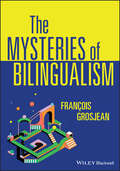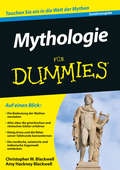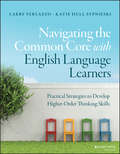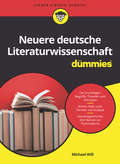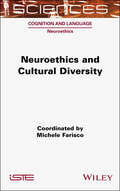- Table View
- List View
Modern Irish Theatre (Polity Cultural History of Literature Series)
by Mary TrotterAnalysing major Irish dramas and the artists and companies that performed them, Modern Irish Theatre provides an engaging and accessible introduction to twentieth-century Irish theatre: its origins, dominant themes, relationship to politics and culture, and influence on theatre movements around the world. By looking at her subject as a performance rather than a literary phenomenon, Trotter captures how Irish theatre has actively reflected and shaped debates about Irish culture and identity among audiences, artists, and critics for over a century. This text provides the reader with discussion and analysis of: Significant playwrights and companies, from Lady Gregory to Brendan Behan to Marina Carr, and from the Abbey Theatre to the Lyric Theatre to Field Day; Major historical events, including the war for Independence, the Troubles, and the social effects of the Celtic Tiger economy; Critical Methodologies: how postcolonial, diaspora, performance, gender, and cultural theories, among others, shed light on Irish theatre’s political and artistic significance, and how it has addressed specific national concerns. Because of its comprehensiveness and originality, Modern Irish Theatre will be of great interest to students and general readers interested in theatre studies, cultural studies, Irish studies, and political performance.
Modern Literary Theory and Ancient Texts: An Introduction
by Thomas SchmitzThis book provides students and scholars of classical literature with a practical guide to modern literary theory and criticism. Using a clear and concise approach, it navigates readers through various theoretical approaches, including Russian Formalism, structuralism, deconstruction, gender studies, and New Historicism. Applies theoretical approaches to examples from ancient literature Extensive bibliographies and index make it a valuable resource for scholars in the field
Modern Literatures in Spain
by Jo Labanyi Luisa Elena DelgadoJo Labanyi and Luisa Elena Delgado provide the first cultural history of modern literatures in Spain. With contributors Helena Buffery, Kirsty Hooper, and Mari Jose Olaziregi, they showcase the country&’s cultural richness and complexity by working across its four major literary cultures – Castilian, Catalan, Galician, and Basque – from the eighteenth century to the present. Engaging critically with the concept of the &“national&”, Modern Literatures in Spain traces the uneven institutionalization of Spain&’s diverse literatures in a context of Castilian literary hegemony, as well as examining diasporic and exile writing . The thematically organized chapters explore literary constructions of subjectivity, gender, and sexuality; urban and rural imaginaries; intersections between high and popular culture; and the formation of a public sphere. Throughout, readings are attentive to the multiple ways in which literature serves as a barometer of cultural responses to historical change. An introduction to major cultural debates as well as an original analysis of key texts, this book is essential reading for students and scholars with an interest in the literatures and cultures of Spain.
The Modern Novel: A Short Introduction (Wiley Blackwell Introductions to Literature)
by Jesse MatzThis book introduces readers to the history of the novel in the twentieth century and demonstrates its ongoing relevance as a literary form. A jargon-free introduction to the whole history of the novel in the twentieth century. Examines the main strands of twentieth-century fiction, including post-war, post-imperial and multicultural fiction, the global novel, the digital novel and the post-realist novel. Offers students ideas about how to read the modern novel, how to enjoy its strange experiments, and how to assess its value, as well as suggesting ways to understand and appreciate the more difficult forms of modern fiction Pays attention both to the practice of novel writing and to theoretical debates among novelists. Claims that the novel is as purposeful and relevant today as it was a hundred years ago. Serves as an excellent springboard for classroom discussions of the nature and purpose of modern fiction.
Modernism: Keywords (Keywords in Literature and Culture (KILC).)
by Melba Cuddy-Keane Adam Hammond Alexandra PeatGuided by the historical semantics developed in Raymond Williams' pioneering study of cultural vocabulary, Modernism: Keywords presents a series of short entries on words used with frequency and urgency in “written modernism,” tracking cultural and literary debates and transformative moments of change. Short-listed for The Modernist Studies Association 2015 Book Prize for an Edition, Anthology, or Essay Collection Highlights and exposes the salient controversies and changing cultural thought at the heart of modernism Goes beyond constructions of “plural modernisms” to reveal all modernist writing as overlapping and interactive in a simultaneous and interlocking mix Draws from a vast compilation of more than a thousand sources, ranging from vernacular prose to experimental literary forms Spans the “long” modernist period, from its incipient beginnings c.1880 to its post-WWII aftermath Approaches English written modernism in its own terms, tempering explanations of modernism often derived from European poets and painters Models research techniques based on digital databases and collaborative work in the humanities
Modernism: Keywords (Keywords in Literature and Culture (KILC).)
by Melba Cuddy-Keane Adam Hammond Alexandra PeatGuided by the historical semantics developed in Raymond Williams' pioneering study of cultural vocabulary, Modernism: Keywords presents a series of short entries on words used with frequency and urgency in “written modernism,” tracking cultural and literary debates and transformative moments of change. Short-listed for The Modernist Studies Association 2015 Book Prize for an Edition, Anthology, or Essay Collection Highlights and exposes the salient controversies and changing cultural thought at the heart of modernism Goes beyond constructions of “plural modernisms” to reveal all modernist writing as overlapping and interactive in a simultaneous and interlocking mix Draws from a vast compilation of more than a thousand sources, ranging from vernacular prose to experimental literary forms Spans the “long” modernist period, from its incipient beginnings c.1880 to its post-WWII aftermath Approaches English written modernism in its own terms, tempering explanations of modernism often derived from European poets and painters Models research techniques based on digital databases and collaborative work in the humanities
Modernism: A Short Introduction (Wiley Blackwell Introductions to Literature)
by David AyersThis short introduction to Modernism analyses the movement from the perspective of English and American literature. Provides a critical overview of some of the central texts of literary Modernism. Covers both established works and those that have only recently come to critical attention. Includes detailed discussion of major authors, including T.S. Eliot, Virginia Woolf, D.H. Lawrence, Wallace Stevens and H.D.
Modernism (Blackwell Guides to Criticism)
by Michael H. WhitworthThis guide helps readers to engage with the major critical debates surrounding literary modernism. A judicious selection of key critical works on literary modernism Presents a critical history from the earliest reviews to the most recent theoretical assessments Shows how modernist writers understood and constructed modernism. Shows how succeeding generations have developed those constructions and brought new interpretations to bear on the subject Discusses how modernism relates to modernity and odernization, and to other literary and cultural movements Texts have been selected for their relevance to the questions surrounding modernism, and for their accessibility to readers with a limited knowledge of the modernist canon Includes a glossary and an annotated bibliography.
Modernist Literature: Challenging Fictions?
by Vicki MahaffeyThis inclusive guide to Modernist literature considers the ‘high’ Modernist writers such as Eliot, Joyce, Pound and Yeats alongside women writers and writers of the Harlem Renaissance. Challenges the idea that Modernism was conservative and reactionary. Relates the modernist impulse to broader cultural and historical crises and movements. Covers a wide range of authors up to the outbreak of World War II, among them Oscar Wilde, Joseph Conrad, Henry James, Langston Hughes, Samuel Beckett, HD, Virginia Woolf, Djuna Barnes, and Jean Rhys. Includes coverage of women writers and gay and lesbian writers.
Morphology: A Distributed Morphology Introduction
by Jeffrey P. PunskeThe first comprehensive morphology textbook written in the framework of Distributed Morphology, firmly grounded in cross-linguistic theory Distributed Morphology is the theoretical framework that views morphology as syntactic, proposing that there is no divide between the construction of words and the construction of sentences. The first text of its kind, Morphology: A Distributed Morphology Introduction provides a thorough overview of Distributed Morphology using data and problem sets from a diverse selection of the world's languages. Divided into two parts, this valuable resource begins by describing the basics of morphology and then moves into an exploration of more advanced topics in morphology including morphosyntactic operations, cyclic derivation, the Mirror Principle, and non-compositional language. Each chapter includes a glossary of key terms, learning objectives, further readings, and illustrative examples to reinforce learning. Exercises and problem sets encourage students to develop their understanding and build confidence in the application of theory to practice. Through this valuable text, students will develop comprehension in morphological parsing and glossing, the concept of the lexicon, the different types of morphemes, the idea of paradigms, the basic practice of morphological analysis, and more. Offering detailed yet accessible coverage of morphological theory from the perspective of Distributed Morphology, this textbook: Introduces the methodology used in morphology, the basic assumptions of Distributed Morphology, and key concepts from lexical grammatical approaches to language Covers essential phonology, feature interaction, paradigms as linguistic objects, core ideas of syntax and syntactic derivation, and derivation and inflection in Distributed Morphology Includes a Quick Reference Guide with glossing abbreviations from the Leipzig Glossing Rules, a full IPA chart with instructions, and charts of phonological features Provides access to a companion website containing solutions to problem sets and additional instructor resources Morphology: A Distributed Morphology Introduction is the ideal textbook for advanced undergraduates and graduate students in morphology courses or with an interest in specializing in morphology. Offering students an unparalleled overview of this growing field of morphology, this text will ensure that developing morphologists are well-equipped to employ the latest methods in Distributed Morphology to their own research and study.
Morphology: A Distributed Morphology Introduction
by Jeffrey P. PunskeThe first comprehensive morphology textbook written in the framework of Distributed Morphology, firmly grounded in cross-linguistic theory Distributed Morphology is the theoretical framework that views morphology as syntactic, proposing that there is no divide between the construction of words and the construction of sentences. The first text of its kind, Morphology: A Distributed Morphology Introduction provides a thorough overview of Distributed Morphology using data and problem sets from a diverse selection of the world's languages. Divided into two parts, this valuable resource begins by describing the basics of morphology and then moves into an exploration of more advanced topics in morphology including morphosyntactic operations, cyclic derivation, the Mirror Principle, and non-compositional language. Each chapter includes a glossary of key terms, learning objectives, further readings, and illustrative examples to reinforce learning. Exercises and problem sets encourage students to develop their understanding and build confidence in the application of theory to practice. Through this valuable text, students will develop comprehension in morphological parsing and glossing, the concept of the lexicon, the different types of morphemes, the idea of paradigms, the basic practice of morphological analysis, and more. Offering detailed yet accessible coverage of morphological theory from the perspective of Distributed Morphology, this textbook: Introduces the methodology used in morphology, the basic assumptions of Distributed Morphology, and key concepts from lexical grammatical approaches to language Covers essential phonology, feature interaction, paradigms as linguistic objects, core ideas of syntax and syntactic derivation, and derivation and inflection in Distributed Morphology Includes a Quick Reference Guide with glossing abbreviations from the Leipzig Glossing Rules, a full IPA chart with instructions, and charts of phonological features Provides access to a companion website containing solutions to problem sets and additional instructor resources Morphology: A Distributed Morphology Introduction is the ideal textbook for advanced undergraduates and graduate students in morphology courses or with an interest in specializing in morphology. Offering students an unparalleled overview of this growing field of morphology, this text will ensure that developing morphologists are well-equipped to employ the latest methods in Distributed Morphology to their own research and study.
Multilingualism in the English-Speaking World: Pedigree of Nations (The Language Library #5)
by Viv EdwardsMultilingualism in the English-Speaking World is the winner of the BAAL Book Prize 2005. Multilingualism in the English-Speaking World: Pedigree of Nations explores the consequences of English as a global language and multilingualism as a social phenomenon. Written accessibly, it explores the extent of diversity in ‘inner circle’ English speaking countries (the UK, the USA, Canada, South Africa, Australia and New Zealand) and examines language in the home, school, and the wider community. Considers the perspectives of English as a global language as well as multilingualism as a social phenomenon. Written in an accessible style that draws on contemporary real life examples. Examines the everyday realities of people living in 'inner circle' English-speaking countries, such as the UK, USA, Canada, South Africa, Australia and New Zealand. Discusses the theoretical issues that underpin current debates, drawing on research literature on societal multilingualism, language maintenance and shift, language policy, language and power, and language and identity.
The Mysteries of Bilingualism: Unresolved Issues
by François GrosjeanEleven critical issues in the study of bilingualism: Insightful analyses by renowned expert François Grosjean The majority of people living around the world today are able to speak more than one language, yet many aspects of the nature and experience of bilingualism raise unresolved questions for researchers. Who exactly is bilingual? What is the extent of bilingualism? How do infant bilinguals who acquire two languages at the same time manage to separate them? Does language processing work differently when bilinguals are interacting with monolinguals and with bilinguals? When a speaker changes their language, do they also change aspects of their personality? In The Mysteries of Bilingualism, eminent scholar François Grosjean provides a comprehensive examination of individual bilingualism that delves into unanswered questions and challenges many of the myths and misconceptions surrounding bilingualism. Through insightful analyses of eleven key questions, this book offers a unique combination of personal reflection, literature review, personal testimony, and case studies to explore these mysteries. Altogether, this text offers: Comprehensive explorations of the linguistic aspects of bilingualism, including who is bilingual, describing bilinguals, accented speech, and language loss Practical discussions of speech and language processing, including language choice and mixed speech perception and production In-depth examinations of personality and culture in relation to bilingualism and biculturalism Perfect for undergraduate and graduate students of bilingualism, multilingualism, second language acquisition, and applied linguistics, The Mysteries of Bilingualism offers an up-to-date view of the leading research questions in the study of bilingualism today.
The Mysteries of Bilingualism: Unresolved Issues
by François GrosjeanEleven critical issues in the study of bilingualism: Insightful analyses by renowned expert François Grosjean The majority of people living around the world today are able to speak more than one language, yet many aspects of the nature and experience of bilingualism raise unresolved questions for researchers. Who exactly is bilingual? What is the extent of bilingualism? How do infant bilinguals who acquire two languages at the same time manage to separate them? Does language processing work differently when bilinguals are interacting with monolinguals and with bilinguals? When a speaker changes their language, do they also change aspects of their personality? In The Mysteries of Bilingualism, eminent scholar François Grosjean provides a comprehensive examination of individual bilingualism that delves into unanswered questions and challenges many of the myths and misconceptions surrounding bilingualism. Through insightful analyses of eleven key questions, this book offers a unique combination of personal reflection, literature review, personal testimony, and case studies to explore these mysteries. Altogether, this text offers: Comprehensive explorations of the linguistic aspects of bilingualism, including who is bilingual, describing bilinguals, accented speech, and language loss Practical discussions of speech and language processing, including language choice and mixed speech perception and production In-depth examinations of personality and culture in relation to bilingualism and biculturalism Perfect for undergraduate and graduate students of bilingualism, multilingualism, second language acquisition, and applied linguistics, The Mysteries of Bilingualism offers an up-to-date view of the leading research questions in the study of bilingualism today.
Mythologie für Dummies (Für Dummies)
by Christopher W. Blackwell Amy Hackney BlackwellAlles von Aphrodite bis Zarathustra Mythologie ist spannender als jeder Krimi, grausamer als jeder Horrorfilm und leidenschaftlicher als jeder Liebesroman. Aber wie hieß noch gleich der Meeresgott der Griechen? Was geschah bei der Götterdämmerung? Und wer gehörte zu König Artus‘ Tafelrunde? Antworten auf diese und viele weitere Fragen finden Sie in diesem Buch, das zum Schmökern einlädt und wunderbar als Nachschlagewerk dient. Neben der griechischen und römischen Mythologie erfahren Sie alles Wissenswerte zu den nordischen Sagen wie den Nibelungen und Beowulf, zu Mythen aus Ägypten und Asien sowie zu den Erzählungen der Inka, Maya und Azteken.
Mythologie für Dummies (Für Dummies)
by Christopher W. Blackwell Amy Hackney BlackwellMythologie ist spannender als jeder Krimi, grausamer als jeder Horrorfilm und leidenschaftlicher als jeder Liebesroman! Wie hieß er doch noch gleich, der Meeresgott bei den Griechen? Was waren bloß die zehn Aufgaben des Herkules? Antworten auf solch typische Fragen nach dem Motto "Wie war das nochmal?" finden Sie in diesem wunderbaren Nachschlagewerk, das zum Schmökern einlädt. Der Schwerpunkt des Buches liegt auf der griechischen und römischen Mythologie, aber auch nordeuropäische Gestalten wie König Artus und Beowulf, weniger bekannte Sagen aus Ägypten und Asien und die Mythen lateinamerikanischer Völker wie den Maya, Azteken und Inkas kommen nicht zu kurz.
Mythology For Dummies
by Amy Hackney Blackwell Christopher W. BlackwellDiscover (or rediscover!) history’s greatest myths and legends From Grendel and Beowulf to Poseidon, Medusa, and Hercules, the gods, monsters, and heroes of mythology are endlessly weird and fascinating. And if you’re looking for a helpful companion to this wild collection of creatures, humans, and deities, you’ve found it! Mythology For Dummies delivers the straight goods on history’s most popular myths, helping you make sense of even the most complicated ancient stories. You’ll learn about the origins of your favorite myths, their cultural impact, and more. Discover: The coolest mythological characters, including intrepid Odysseus, the volatile gods of Mount Olympus, and Thor and Loki How ancient mythology intersects with our daily lives in pop culture, high culture, and everything in between Mythological destinations, like Atlantis, and famous sites from Greek, Roman, and Norse mythologyAn engrossing guide to some of the most enduring and interesting tales from throughout history, Mythology For Dummies serves up the inside scoop on almost every myth or legend you’d care to learn more about.
Mythology For Dummies
by Amy Hackney Blackwell Christopher W. BlackwellDiscover (or rediscover!) history’s greatest myths and legends From Grendel and Beowulf to Poseidon, Medusa, and Hercules, the gods, monsters, and heroes of mythology are endlessly weird and fascinating. And if you’re looking for a helpful companion to this wild collection of creatures, humans, and deities, you’ve found it! Mythology For Dummies delivers the straight goods on history’s most popular myths, helping you make sense of even the most complicated ancient stories. You’ll learn about the origins of your favorite myths, their cultural impact, and more. Discover: The coolest mythological characters, including intrepid Odysseus, the volatile gods of Mount Olympus, and Thor and Loki How ancient mythology intersects with our daily lives in pop culture, high culture, and everything in between Mythological destinations, like Atlantis, and famous sites from Greek, Roman, and Norse mythologyAn engrossing guide to some of the most enduring and interesting tales from throughout history, Mythology For Dummies serves up the inside scoop on almost every myth or legend you’d care to learn more about.
Native American Storytelling: A Reader of Myths and Legends
by Karl KroeberThe myths and legends in this book have been selected both for their excellence as stories and because they illustrate the distinctive nature of Native American storytelling. A collection of Native American myths and legends. Selected for their excellence as stories, and because they illustrate the distinctive nature of Native American storytelling. Drawn from the oral traditions of all major areas of aboriginal North America. Reveals the highly practical functions of myths and legends in Native American societies. Illustrates American Indians’ profound engagement with their natural environment. Edited by an outstanding interpreter of Native American oral stories.
Navigating English Grammar: A Guide to Analyzing Real Language
by Anne Lobeck Kristin DenhamAn engaging and fresh take on the rules and politics of English grammar, written in lively prose. It goes a step further than most books on grammar by providing an overview of the field, with a discussion of historical and current debates about grammar, and how we define, discuss, and approach it. Presents a novel, inquiry-based approach to understanding speakers' unconscious knowledge of English grammar Makes lucid connections, when relevant, with current linguistic theory Integrates language change and variation into the study of grammar Examines historical sources of socially evaluative perceptions of grammar, as 'good' or 'bad', and notions of language authority Provides syntactic explanations for many modern punctuation rules Explores some of the current controversies about grammar teaching in school and the role of Standard English in testing and assessment
Navigating English Grammar: A Guide to Analyzing Real Language
by Anne Lobeck Kristin DenhamAn engaging and fresh take on the rules and politics of English grammar, written in lively prose. It goes a step further than most books on grammar by providing an overview of the field, with a discussion of historical and current debates about grammar, and how we define, discuss, and approach it. Presents a novel, inquiry-based approach to understanding speakers' unconscious knowledge of English grammar Makes lucid connections, when relevant, with current linguistic theory Integrates language change and variation into the study of grammar Examines historical sources of socially evaluative perceptions of grammar, as 'good' or 'bad', and notions of language authority Provides syntactic explanations for many modern punctuation rules Explores some of the current controversies about grammar teaching in school and the role of Standard English in testing and assessment
Navigating the Common Core with English Language Learners: Practical Strategies to Develop Higher-Order Thinking Skills (J-B Ed: Survival Guides)
by Larry Ferlazzo Katie Hull SypnieskiThe must-have Common Core guide for every ESL/ELL instructor Navigating the Common Core with English Language Learners is the much-needed practical guide for ESL/ELL instructors. Written by experienced teachers of English Language Learners, this book provides a sequel to the highly-regarded ESL/ELL Teacher's Survival Guide and is designed to help teachers implement the Common Core in the ELL classroom. You'll find a digest of the latest research and developments in ELL education, along with comprehensive guidance in reading and writing, social studies, math, science, Social Emotional Learning and more. The Common Core is discussed in the context of ESL, including the opportunities and challenges specific to ELL students. Ready-to-use lesson plans and reproducible handouts help you bring these ideas into the classroom, and expert guidance helps you instill the higher-order thinking skills the Common Core requires. The Common Core standards have been adopted in 43 states, yet minimal guidance has been provided for teachers of English Language Learners. This book fills the literature gap with the most up-to-date theory and a host of practical implementation tools. Get up to date on the latest stats and trends in ELL education Examine the challenges and opportunities posed by Common Core Find solutions to common issues that arise in teaching ELL students Streamline Common Core implementation in the ELL classroom The ELL population is growing at a rapid pace, and the ELL classroom is not exempt from the requirements posed by the Common Core State Standards. ESL/ELL teachers know better than anyone else how critical language is to learning, and ELL students need a specialized Common Core approach to avoid falling behind. Navigating the Common Core with English Language Learners provides specific guidance and helpful tools that teachers can bring to the classroom today.
Navigating the Common Core with English Language Learners: Practical Strategies to Develop Higher-Order Thinking Skills (J-B Ed: Survival Guides)
by Larry Ferlazzo Katie Hull SypnieskiThe must-have Common Core guide for every ESL/ELL instructor Navigating the Common Core with English Language Learners is the much-needed practical guide for ESL/ELL instructors. Written by experienced teachers of English Language Learners, this book provides a sequel to the highly-regarded ESL/ELL Teacher's Survival Guide and is designed to help teachers implement the Common Core in the ELL classroom. You'll find a digest of the latest research and developments in ELL education, along with comprehensive guidance in reading and writing, social studies, math, science, Social Emotional Learning and more. The Common Core is discussed in the context of ESL, including the opportunities and challenges specific to ELL students. Ready-to-use lesson plans and reproducible handouts help you bring these ideas into the classroom, and expert guidance helps you instill the higher-order thinking skills the Common Core requires. The Common Core standards have been adopted in 43 states, yet minimal guidance has been provided for teachers of English Language Learners. This book fills the literature gap with the most up-to-date theory and a host of practical implementation tools. Get up to date on the latest stats and trends in ELL education Examine the challenges and opportunities posed by Common Core Find solutions to common issues that arise in teaching ELL students Streamline Common Core implementation in the ELL classroom The ELL population is growing at a rapid pace, and the ELL classroom is not exempt from the requirements posed by the Common Core State Standards. ESL/ELL teachers know better than anyone else how critical language is to learning, and ELL students need a specialized Common Core approach to avoid falling behind. Navigating the Common Core with English Language Learners provides specific guidance and helpful tools that teachers can bring to the classroom today.
Neuere Deutsche Literaturwissenschaft für Dummies (Für Dummies)
by Michael WillNeuere Deutsche Literaturwissenschaft für Dummies ist eine modular angelegte, lebendig präsentierte und leicht verständliche Alternative zu bisherigen literaturwissenschaftlichen Einführungsbüchern. Es hilft unnötige Barrieren überwinden und macht das literaturwissenschaftliche Denken und Grundwissen für Studienanfänger zugänglich, egal, welche Voraussetzungen sie mitbringen. "Neuere Deutsche Literaturwissenschaft für Dummies" präsentiert kompetent und unterhaltsam alle wichtigen Bereiche des Faches (Begriffliche Grundlagen, Textanalyse, Literaturgeschichte, Methodik, Arbeitstechniken) bis zum B.A.-Niveau und legt das Fundament für ein weiterführendes Studium.
Neuroethics and Cultural Diversity
by Michele FariscoThere is a growing discussion concerning the relationship between neuroethical reflections and cultural diversity, which is among the most impactful factors in shaping neuroethics, both as a scientific discipline and a social enterprise. The impacts of culture on science and its public perception are particularly relevant to neuroethics, which aims to facilitate the creation of an interface between neuroscience and society at large. Time is ripe for neuroethics to review the influence of the culturally specific contexts from which it originated (i.e. North America and Western Europe) and to also include other cultural perspectives in the discussion. This book illustrates a convergent approach among different cultures in identifying the main issues raised by neuroscience and emerging technologies. This should be taken as a starting point for advancing in the search for shared solutions, which are, if not definitive, at least sufficiently reliable to be translated into democratic deliberative processes.










